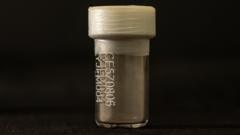In a groundbreaking moment for scientific research, the first moon dust samples from China's Chang'e 5 mission have arrived in the UK, marking a historic milestone in lunar studies. The samples are currently secured in a high-security facility in Milton Keynes, where they will be analyzed by Professor Mahesh Anand, the only UK scientist granted access to this precious material, described as "more precious than gold dust."
The samples, collected during China's 2020 mission, consist of tiny grains of lunar flour dispersed within vials that hold immense potential for research. Professor Anand has a goal of unraveling fundamental mysteries related to the Moon’s formation and the early Earth. Initial examinations will explore the theory that the Moon originated from debris created when Earth collided with a Mars-sized planet approximately 4.5 billion years ago.
The samples provide a new opportunity for collaboration among international researchers, as China has extended a rare invitation to global scientists to explore its lunar findings. During a ceremonial handover in Beijing, Professor Anand expressed his excitement at working alongside esteemed colleagues from around the world. "It was almost like a parallel universe—China is leading in their investment in space programs," he remarked.
For the meticulous analysis, Professor Anand and his team have adopted rigorous contamination-prevention protocols within their lab. This sterile environment ensures that no Earthly particles interfere with the lunar dust, as even the smallest contamination could hinder the scientific analysis of these highly coveted samples.
Inside the lab, a team of skilled technicians, including Kay Knight and Sasha Verchovsky, will employ advanced machinery to dissect the samples. Knight, who has been working with rocks for over three decades, is keenly aware of the high stakes involved, given the limited quantity of moon dust. Verchovsky's bespoke equipment will allow them to extract vital information about the moon's composition, enhancing understanding of its geological history.
Following the success of Chang'e 5, China is also progressing towards future lunar missions, including the Chang'e 6 mission, which aims to bring back samples from the Moon’s far side. Professor Anand expressed hope that the collaborations between nations will thrive, continuing a tradition of sharing space research, similar to the cooperative efforts following the Apollo missions.
With just one year allotted for their research, Professor Anand's team is poised to contribute valuable insights into our cosmic neighborhood, ensuring that the moon dust does not remain a fleeting curiosity but a cornerstone for scientific discovery and collaboration in the years to come.



















